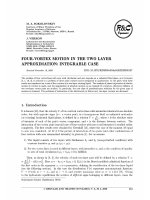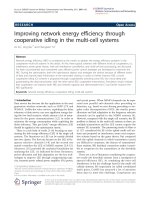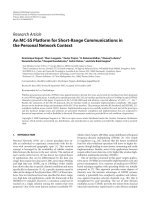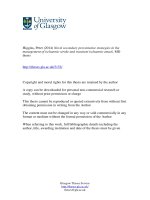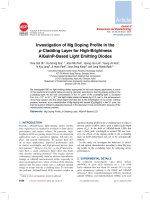Cooperative communications in wireless networks novel approaches in the mac layer
Bạn đang xem bản rút gọn của tài liệu. Xem và tải ngay bản đầy đủ của tài liệu tại đây (1.31 MB, 160 trang )
COOPERATIVE COMMUNICATIONS IN
WIRELESS NETWORKS: NOVEL
APPROACHES IN THE MAC LAYER
Ghasem Naddafzadeh Shirazi
NATIONAL UNIVERSITY OF SINGAPORE
2008
COOPERATIVE COMMUNICATIONS IN
WIRELESS NETWORKS: NOVEL
APPROACHES IN THE MAC LAYER
Ghasem Naddafzadeh Shirazi
(B.Sc., Shiraz University)
A THESIS SUBMITTED
FOR THE DEGREE OF MASTER OF ENGINEERING
DEPARTMENT OF ELECTRICAL AND COMPUTER ENGINEERING
NATIONAL UNIVERSITY OF SINGAPORE
2008
In the name of God, the compassionate; the merciful.
I present this thesis to my father, mother, brother and sister; my dearest teacher,
support, friend and inspiration.
Acknowledgements
When I attended NUS two years ago, I was afraid about my first research experience
and its final outcome. Thanks to the merciful God, I was able to learn a lot and
significantly develop my skills in the social and academic life.
I would like to gratefully acknowledge the kind support of my advisors, Prof.
C.K. Tham and Dr. P.Y. Kong, for their invaluable guides and research directions
during my study at NUS. It was impossible for me to successfully pursue my research,
publish academic papers, and compose this thesis without their wise instructions and
productive advice.
Moreover, I appreciate the A∗ STAR’s generous international graduate scholarship
(IGS), which strongly supported my research and accelerated it towards a master
degree. I am also grateful to the A∗ STAR USCAM-CQ project for providing me a
great research opportunity in the institute for Infocomm. research (I2 R) and bearing
some of my publication fees.
I would also like to thank my friends, Mojtaba Binazadeh and Hossein Nejati,
who were my admirable companions in the happy and sad moments in Singapore. I
will not forget the enjoyable days we spent together in NUS. Last but not least, I
present this thesis to my family for their priceless support throughout my life.
ii
Contents
Acknowledgements
ii
Summary
vii
List of Figures
ix
List of Tables
xii
List of Symbols
xiii
Abbreviations
xix
1 Introduction
1.1
1
Cooperative Communication . . . . . . . . . . . . . . . . . . . . . . .
4
1.1.1
Relay Selection Schemes in Different System Models . . . . . .
4
1.1.2
Capacity and Performance Metrics . . . . . . . . . . . . . . .
8
1.1.3
Cooperation in Different Layers . . . . . . . . . . . . . . . . .
9
1.2
Ultra Wideband Networks . . . . . . . . . . . . . . . . . . . . . . . .
17
1.3
Markov Decision Process . . . . . . . . . . . . . . . . . . . . . . . . .
26
1.4
Contributions . . . . . . . . . . . . . . . . . . . . . . . . . . . . . . .
29
iii
1.4.1
Cooperative UWB MAC . . . . . . . . . . . . . . . . . . . . .
29
1.4.2
MDP Approach for Cooperative MAC . . . . . . . . . . . . .
30
2 Optimal Cooperative Retransmission Schemes in UWB Networks
31
2.1
Introduction . . . . . . . . . . . . . . . . . . . . . . . . . . . . . . . .
32
2.2
Related Work and Motivation . . . . . . . . . . . . . . . . . . . . . .
35
2.3
System Model . . . . . . . . . . . . . . . . . . . . . . . . . . . . . . .
39
2.4
Cooperation Strategies in a Static Network . . . . . . . . . . . . . . .
45
2.4.1
Proactive Relay Selection
. . . . . . . . . . . . . . . . . . . .
46
2.4.2
Reactive Relay Selection . . . . . . . . . . . . . . . . . . . . .
47
2.4.3
Optimal Relay Selection . . . . . . . . . . . . . . . . . . . . .
48
2.4.4
Probability of Collision in Different Relay Selection Schemes .
49
Cooperation Strategies in a Mobile Network . . . . . . . . . . . . . .
50
2.5.1
Perfect Ranging Information (H = 1) . . . . . . . . . . . . . .
57
2.5.2
No Packet Exchange (H = ∞) . . . . . . . . . . . . . . . . . .
57
2.5.3
Tradeoff Between Update Process and the Expected Throughput 58
2.5.4
Optimal Cooperation Strategies in a Mobile Network . . . . .
60
Performance evaluation . . . . . . . . . . . . . . . . . . . . . . . . . .
62
2.6.1
Throughput . . . . . . . . . . . . . . . . . . . . . . . . . . . .
62
2.6.2
Overhead . . . . . . . . . . . . . . . . . . . . . . . . . . . . .
65
2.6.3
Mobility Model . . . . . . . . . . . . . . . . . . . . . . . . . .
65
2.6.4
Optimal Update Interval . . . . . . . . . . . . . . . . . . . . .
67
2.5
2.6
iv
2.7
Conclusion and Future Work . . . . . . . . . . . . . . . . . . . . . . .
69
3 MDP Approaches for Cooperative Communications in Wireless Networks
70
3.1
Introduction . . . . . . . . . . . . . . . . . . . . . . . . . . . . . . . .
71
3.2
Related Work . . . . . . . . . . . . . . . . . . . . . . . . . . . . . . .
74
3.3
System Model and Assumptions . . . . . . . . . . . . . . . . . . . . .
76
3.4
The Proposed MDP Model . . . . . . . . . . . . . . . . . . . . . . . .
78
3.4.1
Actions . . . . . . . . . . . . . . . . . . . . . . . . . . . . . .
78
3.4.2
State space . . . . . . . . . . . . . . . . . . . . . . . . . . . .
78
3.4.3
Reward function . . . . . . . . . . . . . . . . . . . . . . . . .
81
Solutions to the distributed MDP Model . . . . . . . . . . . . . . . .
82
3.5.1
Distributed Value Functions (DVF) . . . . . . . . . . . . . . .
84
3.5.2
Global Reward-based Learning (GRL) . . . . . . . . . . . . .
85
3.5.3
Distributed Reward and Value Functions (DRV) . . . . . . . .
86
Cooperation Based on the Partially Observable MDP (POMDP) . . .
92
3.6.1
The POMDP Model . . . . . . . . . . . . . . . . . . . . . . .
92
3.6.2
The Model-Free POMDP-Based Learning Approach . . . . . .
96
3.5
3.6
3.7
Performance Evaluation . . . . . . . . . . . . . . . . . . . . . . . . . 100
3.8
Conclusions and Future Work . . . . . . . . . . . . . . . . . . . . . . 109
4 Conclusions and Future Research Directions
v
111
Bibliography
115
Appendix A
Lemma for Finding the Optimal UWB Cooperation Strategy
130
Appendix B
Calculating the Probability of Moving to Adjacent Ovals
131
Appendix C
Calculating the Optimal Update Interval, H∗
133
List of Publications
135
vi
Summary
The cooperative communication in wireless networks has received a significant research attention recently. Due to the broadcast nature of wireless media, the nodes
may receive the signals from their neighboring transmitters. These nodes, known as
relays, can cooperate with the original sender by retransmitting the overheard signal
towards the intended destination. Due to erroneous and time-varying nature of wireless links, the cooperative diversity provided by these relay nodes can significantly
improve the performance of wireless networks.
In this thesis, we focus on the cooperative communication in the medium access
control (MAC) layer, in which several research questions are still unsolved. In order to
address these problems, different novel approaches for the cooperative communication
problem in MAC layer are proposed in this thesis.
The novelty of this thesis is two-fold. We first investigate the problem of cooperative communication in a special type of wireless networks, namely ultra wide-band
(UWB) networks, for the first time in the literature. The importance of cooperation
schemes in UWB is the promising potentials of UWB for developing a robust and
high performance wireless infrastructure. Moreover, we design a novel Markov decision process (MDP) framework for the cooperative retransmission problem in the
wireless networks. This MDP model is proven to be simple, yet very efficient approach
vii
for distributed optimization and decision making in the cooperation problem. In fact,
the proposed MDP-based cooperation schemes are shown to significantly improve the
performance of the wireless networks.
viii
List of Figures
1.1
Different cooperative system models. . . . . . . . . . . . . . . . . . .
1.2
Amplify and forward (AF) and decode and forward (DF) relaying
7
schemes. . . . . . . . . . . . . . . . . . . . . . . . . . . . . . . . . . .
10
1.3
Cooperative communication from different perspectives . . . . . . . .
16
1.4
IEEE 802.15.3 super-frame structure . . . . . . . . . . . . . . . . . .
18
2.1
The UWB relay network model . . . . . . . . . . . . . . . . . . . . .
40
2.2
The UWB cooperation protocol . . . . . . . . . . . . . . . . . . . . .
44
2.3
Values and the corresponding contours of W = P Q at different locations of a 40×40 area when S and D are located at (8, 20) and (32, 20),
respectively. . . . . . . . . . . . . . . . . . . . . . . . . . . . . . . . .
2.4
52
The Markov chain for the mobility model. Each state corresponds to
a value of wk in the contour map. The transition probabilities, PGI (k)
and PGO (k), are determined by Vmax . . . . . . . . . . . . . . . . . . .
2.5
54
The expected system throughput as a function of update interval, H,
for NR = 5 mobile relays in a 20 × 20 area. The values of W are
{0.0, 0.25, 0.5, 0.75, 1.0}. The value of H ∗ = 10 is observed from the
curve. . . . . . . . . . . . . . . . . . . . . . . . . . . . . . . . . . . .
ix
60
2.6
Throughput of UCoRS in the static scenario for NR = 1 and NR → ∞,
and the upper and lower bounds of the mobile scenario’s throughput
for NR = 5 and NR → ∞. The PBT throughput is identical to that
for the mobile scenario’s upper bound, as explained in Section 2.5.1 .
63
2.7
The effect of increasing number of relays on PDR . . . . . . . . . . .
64
2.8
Comparison of total update/coordiation packet overhead in UCoRS,
PBT, and CMAC, when H = 1 and each mobility epoch contains 10
time slots. . . . . . . . . . . . . . . . . . . . . . . . . . . . . . . . . .
2.9
66
Comparison of the simulated mobility model and the Markov model
analysis. . . . . . . . . . . . . . . . . . . . . . . . . . . . . . . . . . .
66
2.10 Throughput as a function of the update interval, H, when d0 = 26m
(P0 =0.12), Vmax =10m/epoch, and NR = 5 relays. . . . . . . . . . . .
67
2.11 Comparison of the expected S-D throughput for different schemes in
the mobile scenario. . . . . . . . . . . . . . . . . . . . . . . . . . . . .
68
3.1
The system model for a general cooperative wireless network. . . . . .
77
3.2
Finite state Markov chain (FSMC) model for the wireless channel. . .
80
3.3
The algorithm which is executed in node Ri for finding the best local
strategy for cooperation in DRV learning method. For DVF and GRL,
the corresponding Q-learning expressions in (3.7) and (3.10) will be used. 90
3.4
The learning algorithm sequence in each time slot.
3.5
The gradient descent cooperation algorithm for the proposed DECPOMDP model.
. . . . . . . . . .
91
. . . . . . . . . . . . . . . . . . . . . . . . . . . . . 101
x
3.6
Comparison of successful transmission per consumed energy in different
methods as a function of number of nodes, λ = 0.6. . . . . . . . . . . 102
3.7
Improvement of J in DRV compared to other methods for different
traffic loads and N = 20 nodes. Y axis shows the percentage of DRV
improvement over GRL, DVF, and non-cooperative models.
. . . . . 103
3.8
The convergence behavior of the distributed MDP methods. . . . . . 104
3.9
The packet error probability in different channel qualities, comparison
between the proposed and the non-cooperative methods. . . . . . . . 105
3.10 The average buffer size comparison between the proposed and the noncooperative methods.
. . . . . . . . . . . . . . . . . . . . . . . . . . 106
3.11 Impact of varying noise (σ1 and σ2 ) on the POMDP’s performance. . 107
3.12 POMDP and MDP performance comparison as a function of number
of relays, K. . . . . . . . . . . . . . . . . . . . . . . . . . . . . . . . . 108
3.13 Performance of DVF and DEC-POMDP learning algorithms for different values of noise (σ1 = σ2 ). Some simulation points omitted for the
purpose of clarity. . . . . . . . . . . . . . . . . . . . . . . . . . . . . . 109
B.1 The probability that a node in an oval leaves it to the outer adjacent
oval. . . . . . . . . . . . . . . . . . . . . . . . . . . . . . . . . . . . . 132
xi
List of Tables
2.1
Simulation parameters for the UWB relay network. . . . . . . . . . .
xii
62
List of Symbols
Note that some variables have been used differently in Chapter 2 and Chapter 3.
Nevertheless, the use of each variable is consistent throughout each individual chapter. The following table provides the list of all symbols used in this thesis, and their
meanings in each chapter.
xiii
Variable
Chapter 2
Chapter 3
α
Pathloss model
Q-learning rate
β
Multi-path tap weights
δ
Time shift for bit 1 in TH-PPM
ǫ
Multi-path delay
Φ
Mobility model transition
FSMC error probability
probability matrix
φ
Transition probability
control parameter in FSC
θ
Movement angle
Policy control parameter in FSC
γ
UWB pathloss exponent
Bellman equation discount factor
λ
Packet arrival rate
Ω
POMDP observation probability
ω
Gaussian mono-cycle pulse
Channel gain
π
Mobility model steady state probability
MDP policy
ψ, σ
Error probabilities in
CSI measurement (POMDP)
τ
Mobility epoch length
xiv
ξ
Autocorrelation function of mono-cycle pulse
MDP steady state probabilities
ρ
Ratio between mobility
Reward function
transition probabilities
A
Cooperation strategy, Area
Action set
a
Cooperation probability
Action
B
Packet length
Own buffer
b
Bit value
b1
Pathloss at the unit distance
C
Collision Probability
c
Cluster index
D
Destination
d
Distance
dr
Reference distance for pathloss
E
Expected cooperation gain
Ep
Transmission power
e
F, F ′
Cooperative buffer
Maximum transmission power
Transmission power
Successful relay sets
f
PDF for FSC policy
fd
Doppler frequency
g
TH-PPM time hopping positions
FSC eligibility traces
H
Update interval
POMDP belief state
xv
h
FSC internal states
J
Throughput per consumed energy
K
Number of active relays
Number of relays (POMDP)
L
Number of multi-paths
Number of FSC internal states
i, j, k, l
Node index
Node index
k
State index
State index
l
Multi-path index
M
Number of mobility contours
m
Number of time slots in a mobility
Number of FSMC states
epoch
N
Number of nodes
Nh
Number of UWB chips
NR
Number of relays
NS
Number of UWB repeat frames
N0
Noise power
Nei
Neighbor list
n
Gaussian noise
O
Oval-shaped contours
o
POMDP observation set
POMDP observation
P
S-R Link quality
MDP transition probability
PGI , PGO
Probability of moving in/out of an oval
p
FSMC steady state probability
xvi
pl
Pathloss model
Q
R-D link quality
Q-function (of MDP)
q
r
FSMC states, SNR value
Received signal
Transmission rate
S
s
MDP State space
Transmitted signal
T
MDP state
FSMC transition probability
Tc
UWB chip duration
Tf
UWB frame duration
t
Time (slot) index
U
Expected throughput
u
Time (slot) index
Number of useful received packets
V
Maximum mobility speed
Value function
v
Mobility speed
Throughput
W
Product of S-R and R-D link qualities
w, w ′
Combined link quality
x
Y
PDF for FSC transition probability
Oval area
y
z
Weight vectors in DVF and DRV
Current FSC status (POMDP)
Radius of oval
Number of transmissions
in one time slot
xvii
xviii
Abbreviations
ACK
Acknowledgement packet
AF
Amplify and Forward
ARQ
Automatic Repeat Request
BEP
Bit Error Probability
BER
Bit Error Rate
CC-CDMA
Complementary Coded CDMA
CDMA
Code division Multiple Access
CMAC
Cooperative MAC
CoopMAC
Cooperative MAC
CSI
Channel State Information
CSMA/CA
Carrier Sense Multiple Access / Collision Avoidance
CTA
Channel Time Access
CTS
Clear To Send
CTAP
Channel Time Allocation Period
Cx
Cooperation subslot
D
Destination node, Receiver
DCC
Dynamic Channel Coding
DEC-MDP
Decentralized MDP
DEC-POMDP
Decentralized POMDP
xix
DF
Decode and Forward
DP
Dynamic Programming
DRV
Distributed Reward and Value Functions
DSSS
Direct Sequence Spread Spectrum
DVF
Distributed Value Functions
FCC
Federal Communications Commission
FDMA
Frequency Division Multiple Access
FSC
Finite State Controller
FSMC
Finite State Markov Channel model
GE
Gilbert-Elliot channel model
GPS
Global Positioning System
GRL
Global Reward-based Learning
HTS
Helper to Send
IEEE
Institute of Electrical and Electronics Engineers
IR-UWB Impulse Radio UWB
LC
Link Confirmation
LE
Link Establishment
MAC
Medium Access Control layer
MDP
Markov Decision Process
MIMO
Multiple Input, Multiple Output Antenna
MUI
Multi User Interference
NAK
Negative Acknowledgement Packet
NCSW
Node Cooperative Stop and Wait method
xx
NCTS
Not Clear To Send
NET
Network layer
ORA
Optimal Relay Assignment
PBT
Priority-based Back-off Timer
probability Distribution Function
PDR
Packet Delivery Ratio
PHY
Physical layer
PNC
Piconet Coordinator
POMDP
Partially Observable Markov Decision Process
R
Relay node, Helper node, Agent
RA
Relay Acknowledgement
RB
Relay Broadcast
RL
Reinforcement Learning
RREP
Route Reply
RREQ
Route Request
RTS
Request To Send
S
Source node, Transmitter
S&W
Stop and Wait ARQ
SINR
Signal to Interference and Noise Ratio
SNR
Signal to Noise Ratio
STC
Space-Time Codes
TDMA
Time Division Multiple Access
xxi
THS
Time Hopping Sequence
TH-UWB
Time Hopping UWB
TS
Transmission Start
Tx
Direct transmission subslot
UCAN
UWB Concepts for Ad hoc Networks
UCoRS
Ultra Wideband-based Cooperative Retransmission Scheme
UMAC
Ultra Wideband MAC
UWB
Ultra Wideband
WPAN
Wireless Personal Area Network
xxii
Chapter 1
Introduction
Cooperative communication is a promising method for improving the performance of
wireless networks. The diversity gain provided by the cooperation among the wireless
nodes can be utilized to mitigate the effects of fading in the wireless links. In fact,
due to the bursty error behavior of the wireless channel, the direct transmission from
a source node (S) might not be always received correctly by the intended destination
(D). However, due to the broadcast nature of the wireless medium, the nodes which
are in the transmission range of S may overhear the transmitted signal. These nodes,
known as the relay nodes (R), can cooperate with S by retransmission of this signal
towards D if they happen to have better link qualities to D compared to the direct
S-D link.
The idea of cooperation among nodes is similar to the multiple-input, multipleoutput antenna (MIMO) approach [1] which provides diversity by putting multiple
antennas on a wireless node. The cooperative communication can provide diversity by
virtually using the relays as supportive antennas for the original transmission, hence
it is sometimes called virtual MIMO [2]. The cooperative communication is capable
of providing significant performance gains for the wireless channel due to the fact
that fading occurs independently in each link and hence, the probability of having a
1


